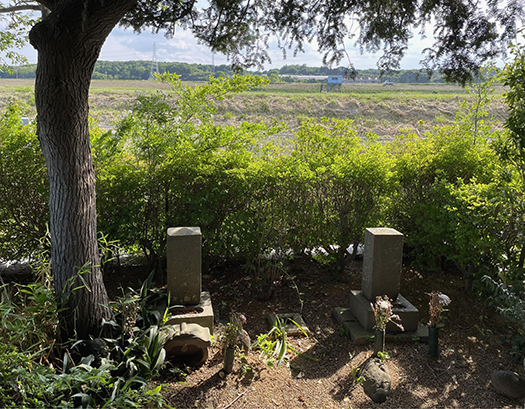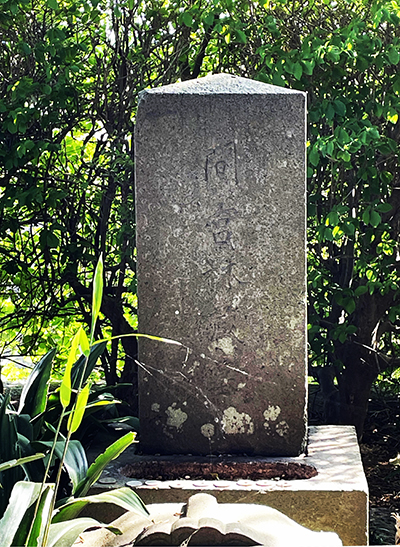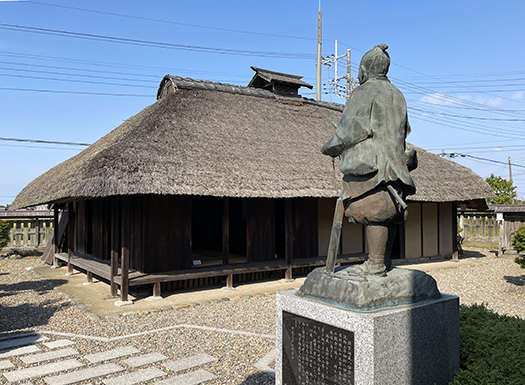


さて長く間宮林蔵さんの事跡に沿って連載記事になってしまいました。人間と住宅、それも北海道に深く関係した歴史的人物についてのことだったので、実際に現地を訪れられたことをきっかけにして思わず深掘りすることになりました。
で、間宮林蔵生家から歩いて数分の場所には間宮家の菩提寺「専称寺」もあって一隅にある「間宮家」の墓参することもできた。要するにその人物の誕生から墓場まで一覧できたという印象を持てた。
ながく待望されてようやく授かったひとり息子。愛情に恵まれて育ったかれは神童と呼ばれ、幕府の土木工事に際して才気あふれる提案をして採用されると同時に、その器量を見込まれて、幕府に出仕してその理工系の才気を活かして、折からの北辺の危機状況の打開のための調査活動に身命を捧げ、日本を救うような決定的な事跡を残した。そして幕臣としての定めに生きて江戸で死去した。
この墓は、かれが樺太探検に向かう前に専称寺の一隅に生前葬というようなカタチで自分の墓を建てたものだという。墓に記された「間宮林蔵墓」の文字はかれが自筆したものだと伝わっている。ひとり息子でありながら家を継ぐことができない親不孝をわび、生家には親族からの養子を取って継がせて、自分は「死んだ」ことにして墓を建てた。ということか、あるいは北辺の樺太探検に向かうのにその「決死」の覚悟から、そのようにしたのか。伝わってくる心事はどちらもあったのだろう。ただ間宮林蔵には北海道でアイヌ女性との縁があって、その子孫も現存されているという。最近明らかになったとのこと。
この墓の隣には両親の墓も建ててある。生まれ育った家で与えられた愛情に深く感謝し、その両親と共に眠っている様子がなんともほほえましくもあり、一方でその無念の心事も伝わってくる。
しかし、人間、その生まれた家の近くの土地、ふるさとの景色の中に土塊となって眠るというのは、ひとつの理想型でもあるように思える。林蔵少年はこの専称寺の住職から読み書き算盤を学んだのだという。地域の中で人材を育んだ様子もわかる。写真に見えるお寺の生け垣の外には川が流れ、その川は絶えることなくこの地の農業を支え続けているのだろう。そしてこの川で魚を捕ったりもしたことだろう。まさに故郷。

住宅メディアの仕事をしてきている自分ですが、こういういわば揺りかごから墓場までという、家と人間のルポというタイプの「取材」は得がたい体験。家は人間のくらしの器であり、そのこころを揺籃するものだということが現実体験できた気分。
自分が加齢してくるとだんだんこういう住宅行脚、ルポが興味深くなってくる。
English version⬇
The Soul Returns to the Soil of the Hometown – Rinzo Mamiya’s Birthplace – 11
The soil of his hometown, where he learned to read, write, and do arithmetic and where his character was nurtured, concludes his life. The scene of his eternal rest, embraced by the love of his parents and the land. …
Well, it has been a long series of articles along the trail of Rinzo Mamiya. Since it was about a historical figure who was deeply related to human beings and houses, and also to Hokkaido, it was a good opportunity for me to actually visit the site. So, within a few minutes’ walk from Rinzo Mamiya’s birthplace, there was also a family temple of the Mamiya family called “Sensho-ji,” and I was able to visit the grave of the Mamiya family in a corner of the house. In short, I had the impression that I was able to see the entire history of the Mamiya family from its birth to its gravesite.
After a long wait, he finally had a son, an only child. He was called a child prodigy, and was called a child prodigy when he proposed a brilliant idea for a civil engineering project of the Shogunate, which was adopted. He left a decisive mark that saved Japan. He died in Edo (Tokyo), living up to his destiny as a shogunate vassal.
This tomb is said to have been erected in a corner of Senjyo-ji Temple before he left for Sakhalin expedition, as a kind of a prenatal burial. The words “Mamiya Rinzo Tomb” inscribed on the grave are said to be in his own handwriting. Rinzo Mamiya was sorry for his lack of filial piety as the only son who could not take over his family, so he adopted a son from his relatives to take over his family of birth and built his own grave, pretending that he was “dead”. Or, did he do this because he was determined to “die” on his way to explore Sakhalin on the northern frontier? Both of these may have been the message conveyed to the audience. However, Rinzo Mamiya had a connection with an Ainu woman in Hokkaido, and some of her descendants are said to be alive today. This has recently been revealed.
His parents’ graves were also erected next to this grave. It is heartwarming to see her resting with her parents, deeply grateful for the love they had given her in the house where she was born and raised, and at the same time, it conveys her regret.
It is an idealistic image of a human being to be laid to rest as a lump of earth in the landscape of his hometown, the land near the house where he was born. Rinzo learned to read, write, and do arithmetic from the priest of Senjyo-ji Temple. It also shows how the temple nurtured human resources in the community. Outside the walls of the temple, which can be seen in the photo, is a river, which continues to support the agriculture of the area. The people must have caught fish in this river. This is truly a hometown.
I have been working in the housing media, but this type of “reportage” on houses and people from cradle to grave is a rare experience for me. I felt as if I could actually experience that a house is a vessel for human life and a cradle for the soul of a person.
As I get older, this type of house tour and reportage becomes more and more interesting.
Posted on 5月 26th, 2023 by 三木 奎吾
Filed under: 住宅取材&ウラ話







コメントを投稿
「※誹謗中傷や、悪意のある書き込み、営利目的などのコメントを防ぐために、投稿された全てのコメントは一時的に保留されますのでご了承ください。」
You must be logged in to post a comment.